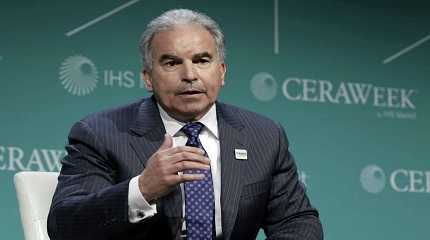
HOUSTON, March 8 (Xinhua) -- The year 2022 was one of both "transformation" and "confirmation" for gas, said policymakers, industry leaders and company executives here at the ongoing annual CERAWeek global energy forum.
"2022 has been a transformational year for our company," Jack Fusco, president and CEO of Cheniere Energy, the largest U.S. gas and liquefied natural gas (LNG) exporter, said during the forum organized by S&P Global and scheduled for March 6-10.
"Seventy percent of our LNG production went to Europe last year," Fusco said, compared to about 60 percent to Asia and some 40 percent to Europe in 2021. The company is projected to produce 80 million tons of LNG per year.
However, for the long run, "Asia remains the main growth target area for gas and LNG," Fusco said.
Cheniere Energy's figure is "rivaling the entire country of Qatar," noted Daniel Yergin, vice chairman of S&P Global and chairman of CERAWeek.
Driven by the Ukraine crisis and the COVID-19 pandemic, oil and gas prices hit record high in 2022. As a result, tens of thousands of customers in the developing world were "priced out" of the expensive LNG market. A recent report by Shell found the demand for gas shrank by 7 million tons in Latin America and 6 million in Southeast Asia last year.
Meanwhile, Europe imported 45 million tons more LNG in 2022 than in 2021, stirring an inter-regional competition with Asia for LNG supply, and in turn, higher gas prices, the report showed.
Attending the same panel with Fusco on Tuesday, which was titled "The Future of Natural Gas," Greg Ebel, president and CEO of Enbridge, one of Canada's biggest energy infrastructure companies, called 2022 a "year of confirmation."
"Natural gas is here to stay for a long time," he said.
In its March Short-Term Energy Outlook released Tuesday, the U.S. Energy Information Administration forecasts that U.S. LNG exports will average 12.1 billion cubic feet per day (Bcf/d) in 2023, up 14 percent year-on-year, and they will increase by an additional 5 percent in 2024 due to high global demand.
"Oil and gas is going to remain a part of the U.S. energy mix for years to come," U.S. Secretary of Energy Jennifer Granholm told CERAWeek audience on Wednesday.
"Economic conditions for gas will remain strong for at least the next two to three years, which will mean that the price of gas will remain historically elevated until probably 2025-2027," Paul Everingham, CEO of Asia Natural Gas & Energy Association, told Xinhua in an exclusive interview at the forum, which has attracted more than 7,000 participants from over 80 countries and regions.
While many energy executives attending the forum have appealed for more investment in oil and gas infrastructure, Ebel repeated his plea for faster permitting, saying it has caused significant delays and cost surges for energy projects in both Canada and the United States.
"It should not take over a decade to get permitting to get transmission for federal land," Granholm said.




